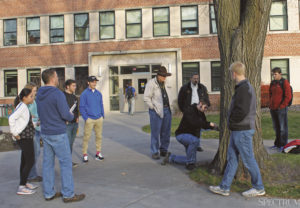The urge to memorialize events or people that have a wide cultural impact is strong — sometimes we carve those events into stone, or mold them from steel or even construct towering buildings of glass and steel in honor of memories.

Or sometimes we plant trees as living memorials.
In 1919 local communities all over the nation participated in a movement to plant memorial trees in honor of the dead from WWI, but in the present day, many people don’t even know these trees exist. They walk by them with no knowledge that the tree they are passing is a living memorial.
“It’s sort of like a form of social amnesia,” Robert Foresman, a Ph.D. student in history, said. “Memorials get commemorated, and then, especially if there isn’t a plaque or sign of some sort, they get forgotten.”
Foresman has been looking into memory trees for the past two years, since he originally found out about them while at the University of Nebraska at Kearney.
“I did a little digging, and found that here at NDSU, there were pictures in the May 19, 1919 edition of The Spectrum of faculty members and students planting these memory trees, as they were called, in honor of students who gave their lives,” Foresman said.
Joe Zeleznik, a forestry specialist with NDSU extension services is part of the project with Foresman trying to identify memory trees on campus by taking core samples and other measurements.
“People would like to think that it’s possible to judge the age of a tree by its size, but that isn’t particularly accurate — it’s necessary to take core samples to get an accurate estimation of the trees’ ages to determine if they are in fact the memory trees that were planted,” Zeleznik said.
The core samples will have to dry for a week before it is possible to determine their age. While NDSU originally had a grove of memory trees, it seems that only two memory trees remain on campus. If the trees are positively identified, potentially plaques could be placed so they remain identified in the future.
“The goal is to encourage engagement with WWI monuments because of the upcoming centennial, but it’s also an opportunity to engage the community, and identify these ‘strangers’ in our midst,” Foresman said.
